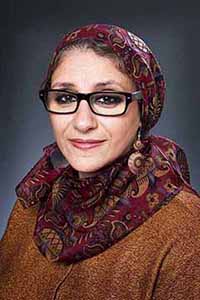Collin Image recently caught up with Dr. Amina K. El-Ashmawy, Professor of Chemistry at Collin College. She was selected as the 2015 U.S. Professor of the Year by the Carnegie Foundation for the Advancement of Teaching and the Council for Advancement and Support of Education (CASE).
Collin Image: As a science educator, what is the biggest challenge that you face?
Dr. El-Ashmawy: Student preparedness and study skills.
Collin Image: What aspect or feature of Collin College are you most proud of?
Dr. El-Ashmawy: Our Core Values are unifying. Also, I work with some amazing and innovative colleagues that help me be more innovative in my methodologies.
Collin Image: What got you interested in Chemistry?
Dr. El-Ashmawy: I always loved science and math. Chemistry made sense in high school, in large part to an amazing teacher, Mrs. Martha McSweeney. When I started college, my father advised me to major in chemistry because of its versatility and wide applicability in the job market. My general chemistry teacher at Kilgore College, Mrs. Anita Neeley, made the subject interesting, relatable and fun to learn. I first joined the American Chemical Society (ACS) while in graduate school. The ACS has provided me many opportunities to collaborate with colleagues from all over the world on various projects. My ACS involvement hasn’t only kept me interested but has greatly benefited me in my career, as well as benefited my students and the college.
Collin Image: What has been the biggest change in the field in last 5 years?
Dr. El-Ashmawy: Teaching has gradually been shifting away from imparting knowledge, sage on the stage model, to facilitating learning. Today, the focus is on learning and outcomes. It makes us reflect more on what we are doing in the classroom and the impact it has on student learning, which is good.
Collin Image: For students interested in the subject, what will be the most appropriate age/grade to get started?
Dr. El-Ashmawy: From birth? My philosophy is to teach children from the very start as much as possible, providing information at the appropriate level for their stage of development. Let me share a story with you to give an example. One evening when my older daughter was two years old, she was sitting in the bathtub and asked me why her nail polish doesn’t get washed away. I told her that the nail polish is nonpolar and water is polar. Because they are different, water won’t wash it away. Although a very simplistic answer, it stuck with her. Twenty years later, in her application essay to Medical Scientists Training Programs, she shared the nail polish story and that it had a profound impact on her thinking. Personally, I was a little surprised that she remembered it, but even more surprised by the impact that one answer had on the direction of her life.
The human mind is capable of much more than we realize. If a child thinks enough about something to ask a question, I strongly believe they deserve an answer. Whatever he or she doesn’t fully understand at the time most likely plants seeds and cultivates curiosity to learn more as they grow.
Collin Image: If you weren’t into chemistry, what would you be doing?
Dr. El-Ashmawy: I would probably be doing something science related.
Collin Image: Would you like to leave us with a formula other than H2O? You can also include a picture or diagram.
Dr. El-Ashmawy: Carbon dioxide is a critical part of respiration and photosynthesis. However, it is also a product of fossil fuel combustion. Since the U.S. is one of the two largest contributors to global climate change (along with China), I thought it fitting to highlight the CO2 molecule.
The below image highlights molecules in methane combustion: water–H2O (left), carbon dioxide–CO2 (right), and methane–CH4 (middle). Methane is the main component of natural gas.
- NRP Group to build the 330-unit Harvard Flats in Princeton - March 28, 2024
- The Home Depot Announces Agreement to Acquire McKinney Texas based SRS Distribution - March 28, 2024
- City of Celina Unveils Exciting Schedule for Friday Night Markets - February 27, 2024




